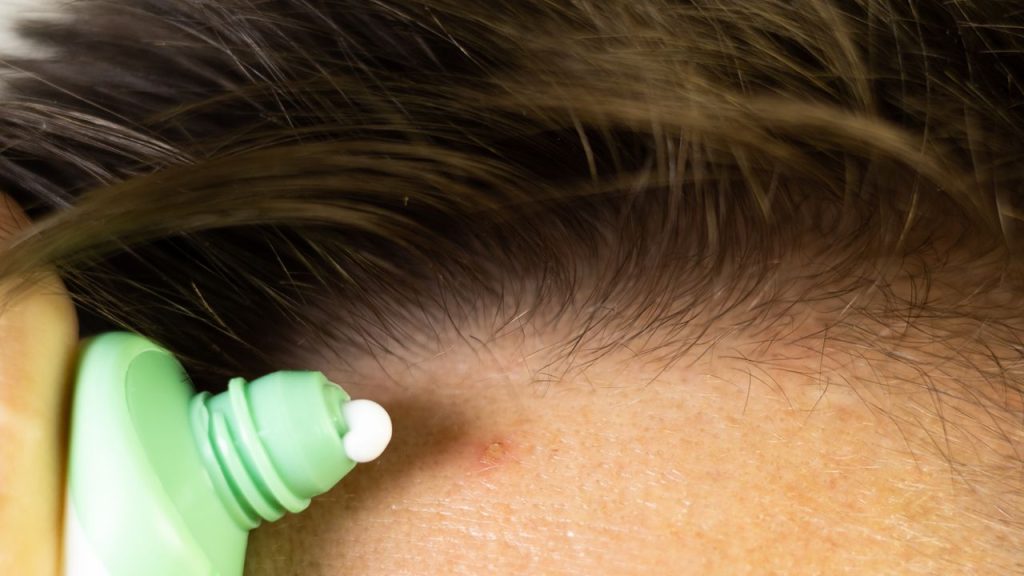“Comedonal acne on the forehead is one of the most common, and these are whiteheads and blackheads caused by clogged pores,” explains Dr. Libby. However, you may also experience papules, which present as small red bumps, or pustules, that have pus in them. “If the acne becomes more inflamed, it can lead to nodules, a.k.a. deeper, more painful breakouts,” adds Dr. Libby, which is why it’s important to keep the area clean and try to treat a spot as soon as it arrives. Prompt treatment is not just for cosmetic reasons—it also prevents the breakout from getting worse.
How to treat forehead acne
Dr. Libby recommends washing with a gentle cleanser that has salicylic acid, which is able to penetrate the pores and dislodge some of the gunk that could be causing the breakout in the first place. We like CeraVe Renewing SA Cleanser. It’s formulated with hyaluronic acid and ceramides to keep the area from drying out.
Dr. Libby advises following up with a benzoyl peroxide spot treatment to kill bacteria and a retinoid like adapalene to unclog pores. Try Acnefree Terminator 10 Acne Spot Treatment Cream, which has a whopping 10% of benzoyl peroxide, or Differin Acne Gel, a go-to at-home retinoid that’s specific to treating acne. These ingredients can be drying, so be sure to use a daily moisturizer too.
Additionally, don’t forget to use your daily SPF, as potent ingredients such as retinoids can be reactive to the sun, causing irritation and even burning. While slathering on a thick sunscreen is probably the last thing you want to do—not to mention, it sounds counterintuitive when trying to keep the pores clear—it’s essential.
“Sun exposure can worsen inflammation, trigger more oil production, and darken post-acne marks, making them last longer,” explains Dr. Libby. “Wearing a noncomedogenic, broad-spectrum sunscreen not only protects your skin but also helps prevent new breakouts and supports the fading of blemishes and discoloration over time.” We recommend the 111Skin Repair Sunscreen SPF 50, as it’s formulated specifically to protect, hydrate, and even tackle hyperpigmentation, which is a common occurrence post breakout.
As for in-office options, Dr. Libby says they include prescription retinoids or antibiotics, chemical peels, light-based treatments, and laser therapies to reduce inflammation and improve skin texture. And if the topicals aren’t cutting it, there are also oral medications like spironolactone or birth control pills that may be prescribed to help.
Can stress cause forehead breakouts?
To put it simply, yes, stress can cause forehead breakouts, but indirectly. Dr. Libby points out that while stress doesn’t directly cause acne, it “triggers the release of cortisol, a hormone that can increase oil production and inflammation in the skin.” Because extra-oily skin conditions paired with inflammation make for the perfect storm, resulting in breakouts, stress can be a driving factor in why you may be breaking out. “Stress can also disrupt your sleep and immune system, making skin more reactive,” adds Dr. Libby.
Forehead bumps vs. acne
It is possible that the bumps you’re seeing on your forehead aren’t acne at all. “Other possibilities include fungal folliculitis (from yeast overgrowth), milia (tiny white cysts), sebaceous hyperplasia (enlarged oil glands), and even keratosis pilaris.” Papulopustular rosacea can also mimic acne with red bumps and pus-filled lesions, but it’s often accompanied by flushing or sensitivity, warns Dr. Libby, which would warrant a different treatment.
Because there are so many other types of forehead bumps other than acne, it’s important to consult with your dermatologist to figure out what exactly you’re experiencing, so that you can treat it properly.
What causes hormonal forehead acne?
“While hormonal acne tends to target the jawline, it can show up on the forehead too,” says Dr. Libby. This is especially common around your period or during times of hormonal fluctuation (like coming off birth control or hormonal shifts during your 20s). “Androgens (like testosterone) stimulate oil production, which leads to clogged pores and inflammation,” she says, which is why treatments like spironolactone and birth control can be helpful.


.png)